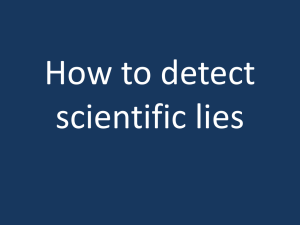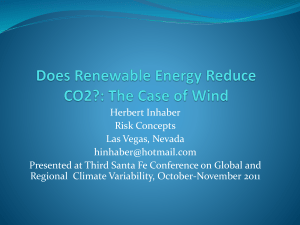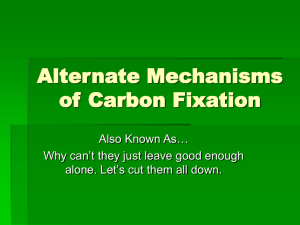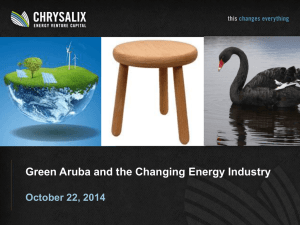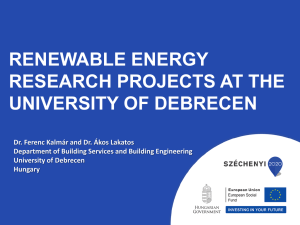ppt
advertisement
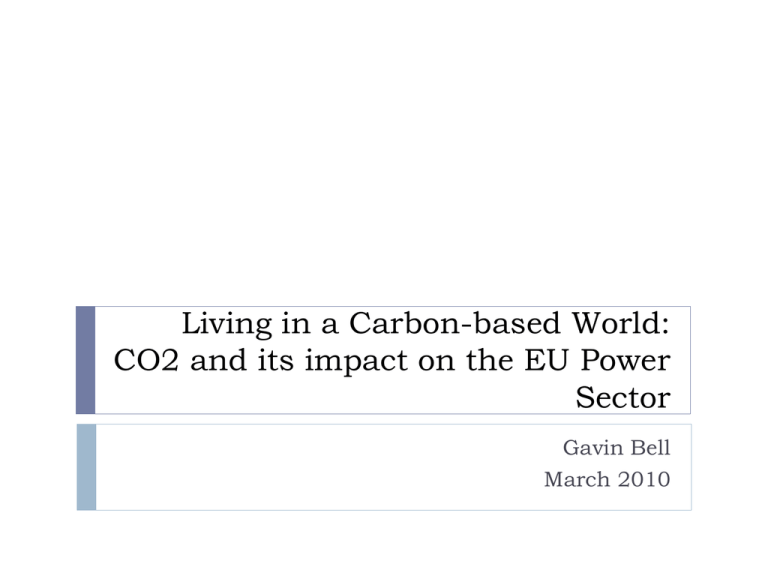
Living in a Carbon-based World: CO2 and its impact on the EU Power Sector Gavin Bell March 2010 First, a little about me... Ph.D. from Canterbury EMRG One of the many from Canty that ended up in Europe... Worked since 1999 in energy sector as consultant and in industry UK, Germany, Austria, Netherlands, Spain, Albania, Montinegro, Macedonia, Norway, Denmark, Czech Republic, Cuba Headed up the continental power market analysis team and the cross commodity analysis team at Statkraft Europe’s largest renewable generator Around 55 TWh annual production Currently CEO of Ably (plant data and analysis firm) and independent consultant 2 Based in Norway since 2003 ecovest limited 13.04.2015 Key EU ETS Takeaways EU ETS market is part of an ”energy complex” involving power, fuels, CO2, and other commodity markets Each drives the other Increasingly, money cannot be made in one market only – you need to look at them all simultaneously CO2 will drive increasing internationalisation of energy markets, as CO2 markets interlink EU ETS in the forefront Any CO2 market is a political beast – politics drives the price and direction 3 ecovest limited 13.04.2015 Outline EU ETS Overview A multi-commodity energy complex Short term interactions Long term interations and drivers Summary 4 ecovest limited 13.04.2015 EU ETS Overview EU ETS – What is it? Technically... Really... Classic cap and trade system to regulate CO2 emissions in the EU + EEA countries Absolute limit on CO2 emissions Allowances distributed to facilities covered by the scheme >12000 facilities >4000 companies Commercially crucially important market in the EU energy sector Driver of investments Participating facilities surrender an allowance per tonne CO2 emitted during annual compliance periods Hedging Exposed to CO2 Need to mitigate to manage risk Trading 6 Impact on price CCS CERs Credit rating ecovest limited Direct opportunity to make money 13.04.2015 ETS Summary 2005 2007 Phase 1 Trial Period • 95% free allowances • Allocation of permits done nationally (National Allocation Plans - NAPs) 7 2008 2012 Phase 2 2013 2020 Phase 3++ Kyoto Period Post-Kyoto Period • Tighter limits based on phase 1 experience (6.5% below 2005) • 90% free allowances • 3% Auctioning • 6% New Entrant Reserve • EEA included • Allocation via NAPs • Can import credits from other flexible mechanisms • Appx. 12% of total • 43% of EU emissions (incl. Aviation, CCS) • Single EU Cap, reducing 1.74% p.a. • Auctioning – 50% in 2013, 100% by 2027 • 100%(ish) auctioning in power sector from 2013 • Links with 3rd Country schemes; harmonisation of CDM/JI rules ecovest limited 13.04.2015 Banking and borrowing Banking and borrowing allowed within a phase No banking or borrowing between phases 1 and 2 A key reason for observed priced development Banking allowed from phase 2 to phase 3 8 Linking prices in these two phases Especially important now phase 2 seems long No borrowing ecovest limited 13.04.2015 Distribution of allowances Two key ”sectors” Cement, Lime, Glass 11% Other 8% Public Power and Heat 59% Oil and Gas 9% Metals 11% Behave differently in relation to ETS Industry Pulp and Paper 2% Generally long Reduce emissions via investment (med-long term) Often annual or ”period” view Power sector 9 Power Industry ecovest limited Generally short CO2 price impacts dispatch Hedging of power production 13.04.2015 EU ETS History 35 30 Fuel bull run 2nd phase NAP cut 25 EUA Price (€/t) Fuel bull run Financial crisis Fuel bear run 20 15 10 5 2005 Verified emissions Industrial length gradually in market Oil, equities bull run 0 2005 2006 2005 10 2006 2007 2007 2008 2008 ecovest limited 2009 2009 2010 13.04.2015 A multi-commodity energy complex CO2 and Power (and fuels, currencies, interest rates etc etc) Complex interactions driving markets Coal Coal Fuel CO2 SRMC 8 10 33 Price of CO2 Fuel CO2 SRMC 8 12 35 Price of gas Gas Gas Fuel CO2 SRMC Fuel CO2 SRMC 20 10 39 15 12 31 Price of CO2 Price of gas 12 ecovest limited 13.04.2015 CO2 and power market interaction Short term The power stack Stack driving emission levels ETS price impacting the stack Non-market external effects Driving power and heat demand and availability (hydro, wind) Hedging, market psychology Energy complex Oil a strong sentiment driver of power and CO2 (++) External economy (e.g. recent demand destruction) 13 Weather Long term CO2 market is key driver in investment decisions Power market investments (emitting vs non-emitting) driver of future CO2 price CO2 price feed-through to power price a driver of future power demand Future CO2 price driver of todays CO2 price (banking effect) ecovest limited 13.04.2015 Question... What is correlation and what is causality? 14 ecovest limited 13.04.2015 Short term interaction The classic – fuel switching SRMC Coal – gas fuel switching Relationship between gas, coal, and CO2 drives stack and emissions Other aspects reduce fuel switch flexibility CO2 cost nuke, wind coal lignite 16 Fuel contracts Inflexibilities in fuel access Don’t always get the fuel switching you expect... gas, oil GT CCGT ecovest limited 13.04.2015 Acc. Changes: fuel prices & weather EUA Dec-08 02 . 01 .2 00 02 8 .0 3. 20 08 02 .0 5. 20 08 02 .0 7. 20 08 02 .0 9. 20 08 02 .1 1. 20 08 02 .0 1. 20 09 02 .0 3. 20 09 02 .0 5. 20 09 02 .0 7. 20 09 02 .0 9. 20 09 02 .1 1. 20 09 Mill tonnes 100 80 60 40 20 0 -20 -40 -60 -80 -100 -120 -140 -160 -180 -200 -220 -240 -260 17 ecovest limited 30 28 26 24 22 20 18 16 14 12 10 8 €/t Impact of fundamentals Source: Point Carbon 13.04.2015 But it’s not a ”tick the boxes” world... 1,00 Relationships are not straightforward, nor consistent 0,50 CO2 - EEX Spot Correlation 1,50 0,00 18.12.2008 28.03.2009 06.07.2009 14.10.2009 22.01.2010 -0,50 -1,00 CO2 - Coal Correlation 1,50 1,00 0,50 0,00 18.12.2008 28.03.2009 06.07.2009 14.10.2009 22.01.2010 -0,50 -1,00 18 Sometimes, CO2 can explain power price movements, sometimes its, say, coal and gas prices, or something entirely different Often possible to know in hindsight... But forecasting is not easy Q: What sort of analysis is useful...? ecovest limited 13.04.2015 Hedging activities Hedging of production begins already 3 years ahead CO2 part of that hedge Thus, begin to hedge production in phase 3 of ETS from 2010 onwards BUT – phase 3 allowances not yet available Via purchase of phase 2 (2012) allowances for banking Year CO2 volumes 2010 250 2011 700 2012 1250 Total 2200 Mt Hedging demand can drive prices 19 ecovest limited Could turn a long phase 2 market into a short one... 13.04.2015 35 160 30 140 120 EUA (€/MWh) 25 100 20 80 15 60 10 5 20 0 0 14.11.2007 20 40 01.06.2008 18.12.2008 06.07.2009 EUA Brent Crude ecovest limited 22.01.2010 10.08.2010 Brent Crude ($/bbl) Crude oil – key sentiment driver Economy driving demand in power and CO2 Mt 2500 Significant demand destruction as a result of financial crisis – from 2008 to 2009: 2000 Less demand for EUAs 1500 2008 2009 2010 2011 2012 Source: Point Carbon 21 Germany: 6% decline France: 3% decline Lower price Pressure on power prices Market is expected long in phase 2... ecovest limited 13.04.2015 Phase 2 market balance 400 short 300 100 0 -100 long -200 2008 EUA Shortage 2009 2010 2011 2012 Credits available for EU ETS Source: Point Carbon 22 Including credits: 970 Mt In theory... 200 Mt Market is long in phase 2 Price in phase 2 should equal discounted price in 2013 (first year, phase 3) Prices today are lower than this... Anticipate at least that phase 3 will increasingly impact phase 2 prices What is driving phase 3 price expectation? ecovest limited 13.04.2015 Long term interaction CO2 price in 2020 and beyond How can we assess the long term price? And thus today’s ”equilibrium” price level? Equilibrium model What price balances supply and demand That is, long term relationships between Power and CO2 Industry and CO2 CERs, other ETS schemes and the EU ETS Or... an educated guess – it is a political process after all 24 What price needed to drive CCS? EU effectively target long term caps to achieve this price level... ecovest limited 13.04.2015 Phase 3 supply: political and commercial process Steadily declining allowance cap 21% below 2005 emissions in 2020 Power sector (more-or-less) 100% short Industry reducing from 80% free allowances in 2013 to 30% in 2020 CERs/ERUs Supply depends on a ”post Kyoto” agreement Credit limit of at least 11% of the phase 2 allocation Can choose when to use the credits (phase 2 or phase 3) 25 No agreement, only Kyoto + ”bilaterals” CERs But, max 1400 Mt in phase 2 ecovest limited 13.04.2015 Phase 3 demand: interation between markets Power and heat Change in stack, through investments and retirements Expected future prices (fuels, capital costs, exhange rates, cost of money) Portfolio considerations Other mechanisms – e.g. Renewables directive Demand for power and heat Industry Economic growth 26 Change in energy intensive industry in EU Change in carbon intensity ecovest limited 13.04.2015 And the results... Bottom up forecast ”Political” forecast... Typical price forecast ranges for CO2 for 2020 Point Carbon 37 €/t Barclays – 40 €/t long term Deutsche Bank 30 €t UBS – 20 €/t UK EAC – 22 €/t Plant investment CCS investment WACC Annualised Load factor CCS capital cost €/kW €/kW The CCS approach (or €/kW/a renewables or whatever...) for, say, 2025 22 €/MWh 75 % cost Additional capital kr 7 €/MWh Reduction in efficiency Fuel cost 75 €/t CO2 emissions11saved €/MWh Efficiency, no CCS 44 % + Efficiency, CCSfuel cost assumptions 34 % Additional Gen. Cost 7 €/MWh etc... Extra fuel cost 36 €/MWh Around 50 €/t 49 (2025) CO2 price Capture rate 90 % Discounts to 35 €/t (2020) CO2 cost saved 36 €/MWh Old load factor Plant capital cost Difference 27 1100 1100 8% 113 50 % ecovest limited 0,00 €/MWh 13.04.2015 Summary Summary CO2 (via ETS) integral part of EU energy markets Complex interactions between these markets Investment Hedging Trading Drive prices Significant and dynamic relationship between long and short term dynamics And don’t forget it is a political process 29 Once there is an ETS, there’s a strong pressure for consistency and predictability ecovest limited 13.04.2015 Gavin Bell ecovest limited Armauer Hansens gate 6a 0455 Oslo, Norway tel: +47 950 27979 bellgj@hotmail.com


